
LIMAHONG CHANNEL TOURISM HUB. The aerial shot of Limahong Channel where the first phase of the Limahong Channel Tourism Center is being constructed. The national government has earmarked PHP50 million for the project. (Photo courtesy of Carlo Rueda)
LINGAYEN, Pangasinan -- The tourism industry here is expected to receive a boost while the local residents have opportunities to work once the construction of the Limahong Channel Tourism Center (LCTC) is completed.
In an interview Monday, Lingayen Mayor Leopoldo Bataoil said the Department of Public Works and Highways (DPWH) is continuously monitoring the construction of the LCTC Phase 1 project which was funded by the national government with PHP50 million.
"The Phase 1 is the construction of the multi-purpose building where various events can be held,” he said.
Bataoil said they have sought the help of the DPWH to ensure the funding of the LCTC Phase 2 project which involves the enclosure of the area, such as the perimeter fence and wharf.
He said a ferry terminal will also be constructed wherein tourists can enjoy a boat ride from the LCTC to the Hundred Islands National Park in Alaminos City.
"Why won't we come up with something like the Lubok River Cruise of Bohol here in Lingayen since there is a historical value of the place?" he said, noting the huge impact of Bohol's river cruise in tourism.
The Limahong Channel had been identified as a tourist spot in 2018 by virtue of House Bill 6682 authored by Bataoil when he was still a representative of the 2nd District of Pangasinan.
Limahong, also known as Lin Feng, is a Chinese pirate who established a base in Pangasinan and raided coastlines in China and Korea during the early 16th century. (PNA)
